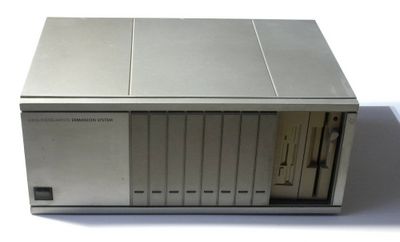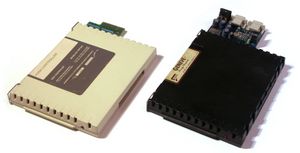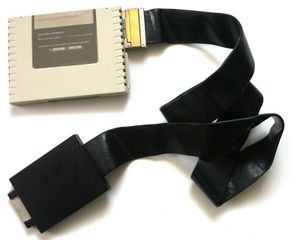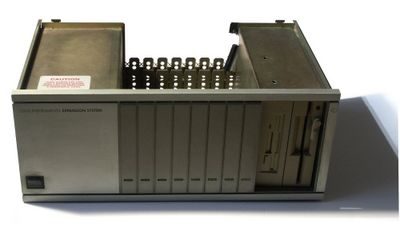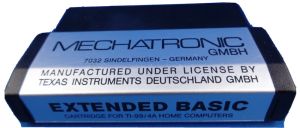Peripheral Expansion System
The Peripheral Expansion Box (aka P-Box or PEB) is a stable, silver/gray plastic and die-cast metal box containing eight slots for peripheral expansion cards and a compartment for a floppy drive or two drives of half height ("slim-line", slim as understood in the 70ies and 80ies; today it is the normal height of 5,25" drives for PCs).
The PEB offers space for 8 expansion cards. All slots are wired in parallel, and the power supply is designed to supply all cards including up to two floppy drives. Floppy drives may be put into the right compartment of the box.
This is a picture of the PEB, with a 3,5" floppy drive in a 5,25" mounting adapter, and to the right a 5,25" floppy drive.
With the appearance of hard disk controller cards, users tried to mount hard drives into the box into the floppy compartment. However, the power supply is not designed to sustain the current required for the hard drives; thus, a separate power supply is recommended.
All peripheral cards are expected to provide their own voltage regulators. Therefore, it is not recommended to replace the power supply by today's PC switched power supplies, as those already provide regulated power which may cause the regulators on the cards to lower the voltage below the acceptable range.
Peripheral Box Slot Concept
Expansion cards are printed circuit boards (PCBs) with a size of approximately 14 cm height and 19 cm width, most cards having an extension with sockets for plugging in cables. Each card contains own voltage regulators as well as bus driver circuits. The cards are usually contained in a
- die-cast case (especially the traditional, original TI cards; colored beige)
- plastic case (newer cards, usually black)
- aluminum case (e.g. cards from Atronic).
As the picture shows, the cards have ventilation holes to allow for an airflow to pass through the case. The slots of the box have matching holes, so the airflow starts in the power supply unit, gets distributed over all slots, and blows out at the rear of the cards.
All peripheral cards are connected to the main address bus, data bus, CRU lines, and control lines in parallel. Each card is required to contain a selection circuitry which allows to turn the card on and off. Apart from the memory expansion cards which are usually always active, all other cards make use of CRU selection. That is, when a certain value is transmitted over the CRU line which corresponds to the value in the card, the card is activated. A LED on the front shows the activity of the card.
The PEB is connected to the console via a special card, called the Flex Cable Interface which is on whenever any card in the PEB is accessed. The thick cable between the console and the PEB is not-so-affectionately known as the "Firehose Cable" by many TI users.
Usually the Flex Cable Interface was placed in slot 1 (leftmost slot) of the PEB.
The other end of the cable connects into the I/O port on the right side of the console, or on the right side of the end of the sidecar components, e.g. into the Speech Synthesizer.
Slot 8 has a access to the floppy compartment, so it usually hosts a disk controller card. The picture shows the floppy data cable passing through a hole in the compartment. The power plug for the floppy drive is led within the case from the power supply to the compartment.
Instead of having the Flex Cable Interface in the box, certain expansion cards may be used which replace the whole TI-99/4A console; most notably:
- Geneve 9640
- SNUG TI-99/4P
Mainbye Projects
The Mainbyte web site has many projects available, including:
It is possible to upgrade the power supply from 12v 1a to 12v 2a if a large number of cards and drives are to be supplied. See Mainbyte project http://www.mainbyte.com/ti99/peb_pow/peb_pow.html
The above link is also useful if the fan works but there is otherwise no power, as some pEBs had a hidden fuse, of a lower rating than the visible fuse.
It is possible to fit a quieter fan to the PEB. See Mainbyte http://www.mainbyte.com/ti99/peb/peb_box_project.html
The MAINBYTE website has been archived on web.archive.org
Expansion Cards from TI
There is a great variety of expansion cards from Texas Instruments and other contributors. They may be organized in the following categories:
- Memory Expansion Cards
- Floppy Disk and Hard Disk Controller Cards
- Serial and Parallel Interface Cards
- Video Enhancement Cards
- Various Expansion Cards
Third-party Expansion Card Contributors
Atronic
Atronic produced hardware for the TI-99/4A in Germany between 1984 and 1987. All of their hardware items are relatively rare, with the Double-Density Floppy Disk Controller being the most common.
Cecure
Cecure bought the rights to Myarc products after Myarc withdrew from the TI market. They also bought the rights to some of the products produces by Rave99, specifically the Speech Interface Adapter. They designed several upgrades to the hardware for the Geneve 9640 and produced a small number of modified Rave99 Speech Interfaces that decoded the AMA, AMB, and AMC address lines necessary for use with the Geneve 9640. They also repaired Myarc products for the TI community.
CorComp
Peripheral Expansions
DataBioTics
Peripheral Expansions
Foundation
Foundation was one of the earliest third-party hardware developers for the TI-99/4A. Their 128K Memory card was the first commercially available RAM Disk, which sold quite well. Their CP/M card worked well but sold poorly, making it a strong contributor to the company's demise.
Horizon
Systems Peripheral Expansions
Mechatronic
Mechatronic GmbH was a German manufacturer for peripheral expansions and software for the TI.
Morning Star
Systems Peripheral Expansions
Myarc
Myarc was a manufacturer of peripheral expansions, most importantly, of the Geneve 9640.
System99 User's Group (SNUG)
The SNUG is a German user group.
